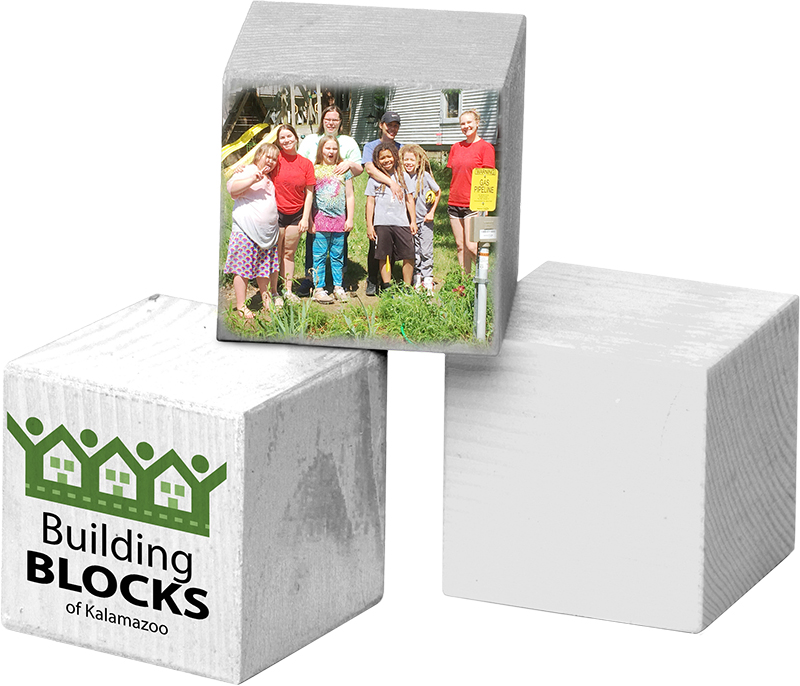
Students Learn by Doing
Through CCE, Building Blocks Partnership
By Fran Czuk
Experiential education is one of the hallmarks of the K-Plan, and each year, hundreds of Kalamazoo College students join the life of the city around them through the Mary Jane Underwood Stryker Center for Civic Engagement (CCE) and its long-standing community partnerships.
Building Blocks of Kalamazoo stands out as an exemplar of those partnerships between K and local schools, groups, organizations and the city. Founded by Professor Emeritus Kim Cummings as a student-neighborhood endeavor in 1995, Building Blocks has since developed into an independent organization that empowers residents, one block at a time, to enhance the quality of their neighborhood life.
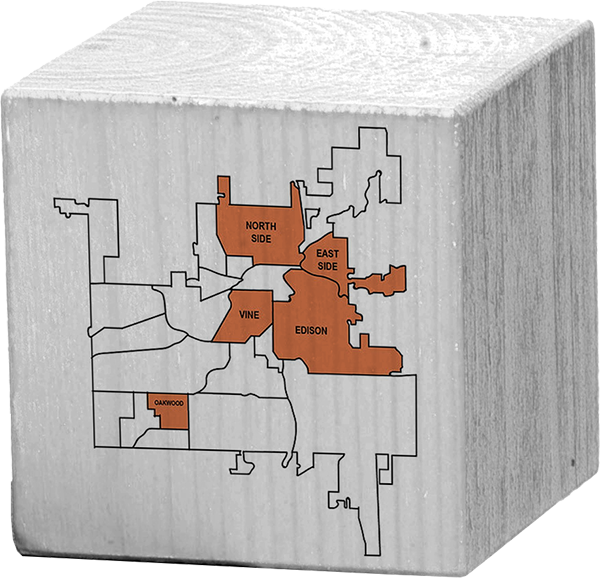
Resident facilitators guide a block’s residents in choosing, planning and enacting projects with funding from Building Blocks. Working together, groups have created community gardens and home landscaping, built ramps and porch railings, and lobbied for and installed better lighting, among other projects. Through the planning process and shared spring and fall work days, participants create and sustain networks of neighbors to continue to work together on block improvements.
K students have engaged with Building Blocks through community-based courses, through summer Community Building Internships, as Civic Engagement Scholars and through Senior Integrated Projects, advancing the CCE’s mission to prepare students to build a more just, equitable and sustainable world, starting locally. The work is enhanced and continued by many K alumni who now serve as urban project partners and mentors for current students.
“Led by community members and drawing on their strengths, the work doesn’t just make important connections between classroom and community—it builds powerful relationships based on trust and mutuality,” said Alison Geist, founding director of the CCE.
Community-based courses

During the 1995 pilot program, Cummings learned three lessons that would shape both Building Blocks and the future structure of community-based courses. The sites should be small; more than one or two students were needed at each site; and the students had limited time to give while balancing a full course load.
The first lesson led to what Cummings said is “one hallmark of Building Blocks, which makes it very distinct and unique, that instead of trying to organize people over a large area, we organize and support people at the street level, at the block level, and we count on people caring about the issues and concerns immediate to them.”
The other two lessons led to the establishment of the first service-learning course at K, Cummings said, “the first course that was fully oriented toward the experience and learning from the experience.” That enabled teams of three students per site to devote more time to their sites and receive adequate preparation as part of the course.
“That course was foundational in my development as a leader and in my own life,” said Katie McPherson ’08, who now serves as Building Blocks executive director. “This notion of believing in people, providing the avenues for people to thrive and seeing it happen, seeing neighbors who didn’t know each other, didn’t trust each other, come together through these community Work Days—it’s magical.”
Students have also engaged with Building Blocks through courses in community organizing, gardening and more.
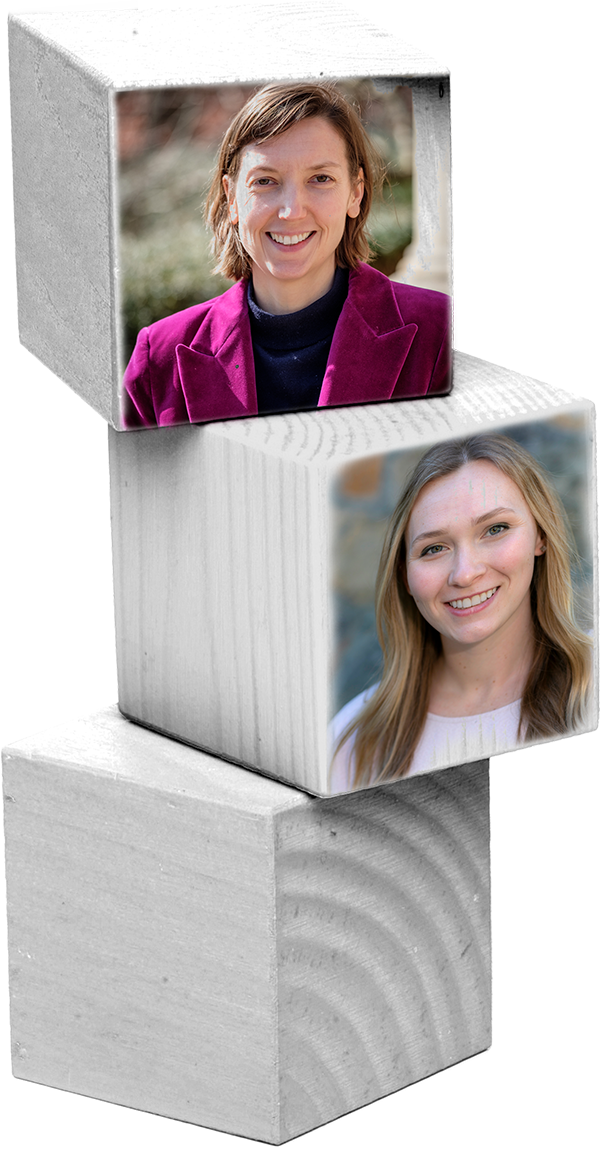
In spring 2022, Marilyn Evans, assistant professor of classics, taught a new community-based seminar with Building Blocks, House in Society in Greco-Roman Antiquity.
At the start of the term, the students and resident facilitators shared a little about themselves in a speed dating-style virtual meeting before rating their preferences of whom to work with. McPherson then matched students with resident facilitators to assist with spring catalyst planning and projects in Kalamazoo neighborhoods.
A double major in biology and history with a classics minor, Ella Knight ’22 enrolled in House in Society in Greco-Roman Antiquity with an interest in connecting history to the present and gaining a better understanding of how community is shaped. She was matched with the Oakwood neighborhood, her first choice.
“As a history major, I liked that the resident facilitator talked about the history of her neighborhood,” Knight said. “I think that showed how important the work is to her and how invested she is.”
In meeting with community organizers and Oakwood families for discussions about projects, budgeting and materials, Knight saw connections to coursework about how people view homes and neighborhoods and how they interact with their community.
“Thinking about it historically, we’ve been looking at Greek and Roman houses, which are very different,” Knight said. “Greek houses were a large family structure with a central courtyard, and everyone in the house interacted in the courtyard itself. Whereas in Roman housing, the goal was for people to look into your house and see every room in the house, so it was much more transparent.
“We met in a park, which seemed to be where people gathered. It was interesting to see that these people who were neighbors hadn’t met before and were realizing they lived two houses apart. They were making connections and forming friendships.”
Those different notions of public and private were key in the course, Evans said. “Strangers normally aren’t in the home, but they walk past the outside; it’s a point of interaction between strangers and people who know each other. Students are starting to think about the role of outdoor spaces specifically in facilitating interactions between people, in the same way that a house in Rome could have been used to do just that.”
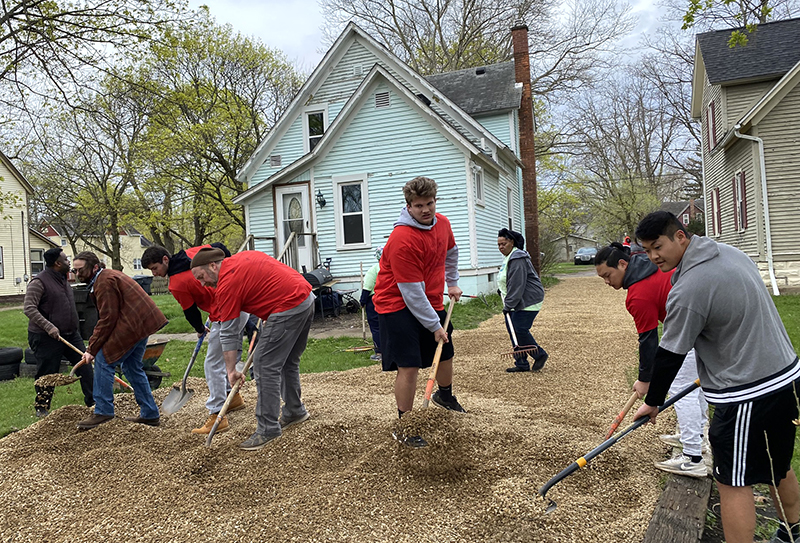
Walker Chung ’22, a chemistry major and classics minor, saw those connections when he attended a Building Blocks Work Day in April. Along with another student from the class and K student-athletes, Chung helped gravel driveways in the Northside neighborhood.
“In ancient Rome, a lot of their houses were for the public,” Chung said. “People would walk into houses and look around, so a lot of it was façade, and their private space was tiny in comparison. While now that has flipped, because we value our privacy a lot more, there are still aspects of the house that are public, like the outside, the backyard, the front yard, the driveway. Little improvements like putting in gravel can change the entire aspect of the house and how people perceive it.”
Evans said students in the course saw how these seemingly superficial improvements matter to residents and the life of the neighborhood. The course included discussion on how much energy the wealthy and elite put into decorating their homes, particularly in ancient Rome, and how the importance of appearance and status show up in modern life.
“They’re starting to see how these small changes are welcoming to people and can be a focal point for people to talk to each other,” Evans said. “It definitely matters to them, the exterior and the act of making it look nicer, or in a lot of cases, making it safer, since a lot of projects are aimed at rebuilding stairs or railings, things like that.”
Chung also saw how the Work Day was a communal experience, with residents directing and assisting with the work, as well as students, nearby residents and family and friends helping out. Those bigger ideas about the role of community in building and maintaining houses were key to the course for Evans.
“We’re talking about how much collaboration is involved in these projects and how, for something that’s seemingly a private and individual affair, it involves a whole community,” Evans said. “Everybody’s involved in making decisions about what’s going to get done, how much money can be spent on it, who’s going to do it. It emphasizes how the work of improving a house or even building it is a communal enterprise.”
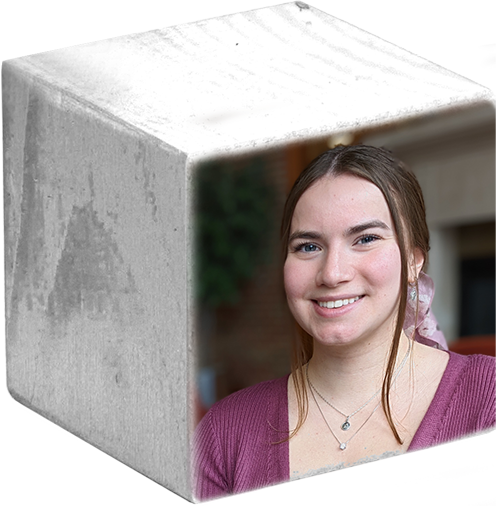
Elle Ragan ’23, a religion and classical civilization double major with an art history minor, observed this process through a strong collaboration with her Vine neighborhood resident facilitators. Ragan attended several meetings with the facilitators as well as neighborhood residents to discuss possible projects, including a walking meeting to observe potential projects.
“It’s been fun building those relationships with the individual community members and meeting them, hearing their stories and about their lives and working through possible roadblocks with them,” Ragan said.
Ragan said as the term progressed, it was illuminating to see students bringing examples from their Building Blocks experience into class discussion. In addition to deepening her understanding of academic and historic concepts, Ragan’s work with Building Blocks helped her develop interpersonal, project management and budgeting skills.
Vine resident facilitator Erika Brown said her experiences with K students have been “phenomenal. I thoroughly enjoyed working alongside them and appreciate all that they brought to our team….After hearing that Katie was involved with Building Blocks when she was a K student, I knew this project was destined for greatness. Katie set the bar high and our students met that bar with flying colors.”
The Vine spring projects this year involved yard and trash pickup, soil distribution and leveling, installing a saucer swing and beautifying a corner curb garden, Brown said.
“Building Blocks is a gift to the core neighborhoods,” she said. “It’s an opportunity to build community while enhancing the neighborhoods.”
Ragan said the resident facilitators are invested in developing the students, often pointing out how their efforts could translate to a resumé and helping them network.
“They are excited for us to be involved and they want us to succeed in Building Blocks and beyond that,” Ragan said. “That has been really heartwarming and we feel so supported even though we’re technically here to support them. It goes both ways.”
Experiences like this were part of Evans’ hopes for the course.
“Many students are concerned about getting jobs after graduation, and they like knowing, as a lot of us do, that their work matters,” Evans said. “In a community-based course, they can consciously make connections between what they’re learning and what they’re doing, get real-life work experience, network and work with people in the community, and learn more deeply about the subject matter in the course—as well as hopefully foster the sense that they’re part of the community and they’re committed to improving it.”
Community Building Internships
As Building Blocks has evolved, a big change has been the addition of Block Action Groups, which build on the spring catalyst sites to support residents in continuing to work together on improvements for longer periods of time. While community-based courses coincide well with the spring catalyst sites and provide an excellent foundation for learning about social change, Geist said, “The 10-week quarter isn’t at all like ‘real life.’ Short-term involvement isn’t conducive to the kind of sustainable partnerships that we know social change requires.”
Therefore, the CCE offers other avenues for partnership programming that enable longer commitments.
For example, Building Blocks consistently participates in the CCE’s Community Building Internship (CBI) program over the summer.
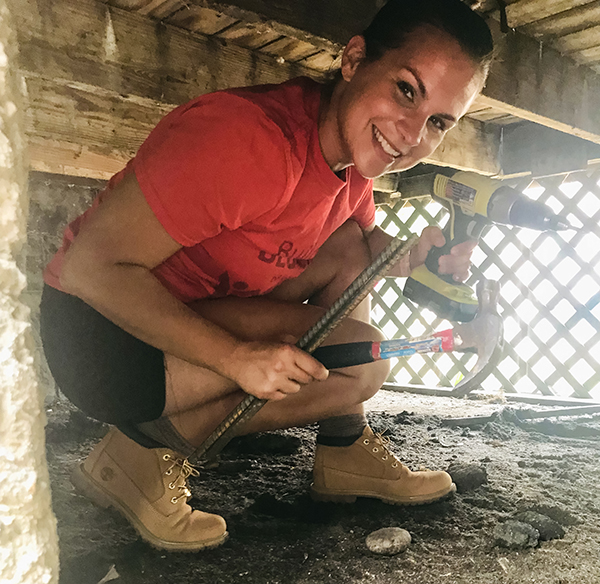
“We take on summer interns every year,” McPherson said. “I love coaching college-age students. It was such a great experience for me at that age, and they want to do right; they want to do well; they’re hungry to improve. They’re really wonderful to work with.”
Interns assist with conducting and analyzing pre- and post-program surveys and assist residents in applying for a continuation grant if the residents want to continue the community work from spring sites throughout the summer.
“That’s their core work,” McPherson said. “From there, I try to work with them on their passions and skills and what they want to get out of the internship. A lot of interns have particular neighborhoods or projects they’re interested in so I try to match them with those interests.”
A past intern who was interested in home repair and passionate about the Northside neighborhood assisted with construction projects in that area. Another who loved serving as an event planner helped take Building Blocks celebration dinners to the next level. McPherson worked to connect the most recent intern, an avid gardener who lives in the Vine neighborhood, with local gardeners and garden projects.
“I have some broad goals for all interns,” McPherson said. “Then I set those final goals based on what they want to get out of the summer program.”
A number of student CBIs have completed Senior Integrated Projects based on their Building Blocks experiences.
Lifelong Learning
“For the vast majority of students, experiential learning opens up possibilities for impassioned engagement by students, with lasting consequences to their outlooks and understanding,” Cummings said. “One can read about low-income neighborhoods, and one can read about populations of poverty, but actually to be involved as participants in the dramas whereby residents grapple with the problems on their street enables a much higher proportion of students to become excited by what they’re discovering, to learn with immediacy and to become emotionally tied to what’s going on. They love the people they work with and they find their own abilities growing and their friendships growing….People’s passions are aroused by seeing the hardships people struggle with and the unfairness of the situations people live with.”
McPherson experienced the power of that experiential learning in her own life and values the ongoing relationship between K and Building Blocks.
“My experience as a Building Blocks student organizer at Kalamazoo College set my life on a path of community organizing and civic engagement,” McPherson said. “I’ve seen this same awakening happen to K students who have worked with Building Blocks. I look forward to continuing our partnership with the College to provide even more opportunities for students to experience this level of direct community engagement. It can truly be a life changing experience.”
For more information or to get involved, visit the Mary Jane Underwood Stryker Center for Civic Engagement at cce.kzoo.edu and Building Blocks at bbkazoo.org
To learn see Building Blocks in action, check out their new video below!